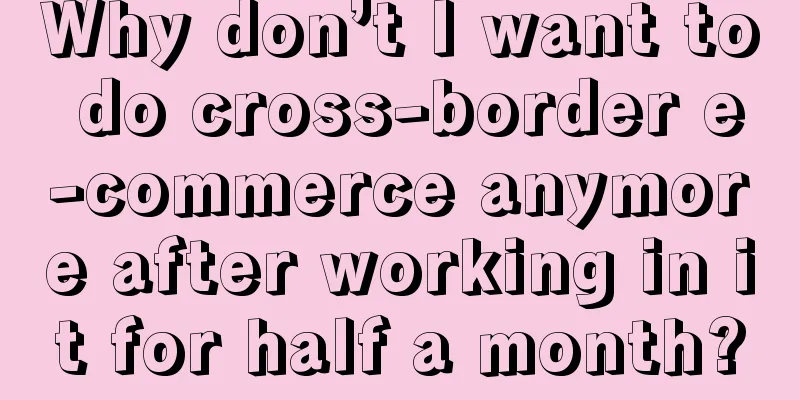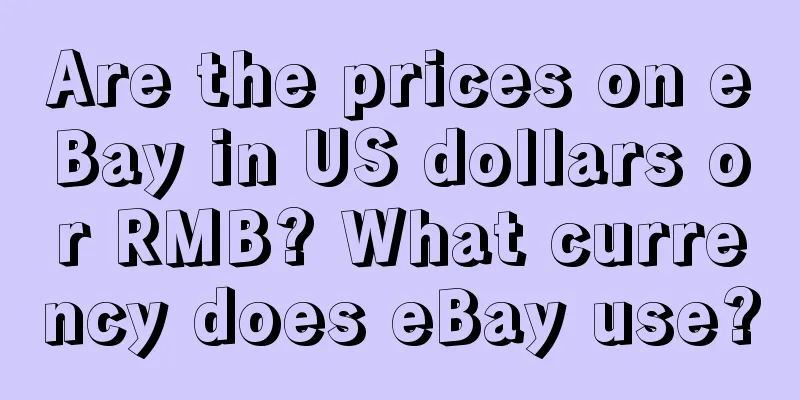Why don’t I want to do cross-border e-commerce anymore after working in it for half a month?

|
As an emerging trade model, cross-border e-commerce has attracted the attention of many entrepreneurs. However, not everyone can succeed in this field. Some people give up after trying for half a month. This article will explore several reasons that may cause entrepreneurs to give up cross-border e-commerce, as well as the funds needed to start cross-border e-commerce. 1. Why do I not want to do cross-border e-commerce after working for half a month? There may be several reasons why entrepreneurs give up cross-border e-commerce in the short term: Intense competition: The cross-border e-commerce market is highly competitive, and it is difficult for new entrants to quickly gain market share. Complex regulations: The laws, regulations and tax policies of different countries are complex and difficult for new entrepreneurs to adapt to. Logistics challenges: Cross-border logistics are costly, time-consuming, and prone to loss or damage of goods. Language and cultural barriers: There are language and cultural differences in communicating with consumers in different countries. Technical threshold: Establishing and maintaining a cross-border e-commerce platform requires certain technical support. Financial pressure: Starting and operating a cross-border e-commerce business requires a certain amount of capital, and the payback period is relatively long. Insufficient market research: Insufficient understanding of target market needs and consumer preferences leads to unpopular products. Lack of experience: Lack of cross-border e-commerce operation experience and marketing skills. 2. How much capital does cross-border e-commerce require? The funds required to start and operate a cross-border e-commerce business vary depending on business size, market positioning, product type, etc. Here are some of the main funding requirements: Platform construction: Building your own e-commerce platform requires investments in website development, server rental, and other expenses. Platform usage fees: When using a third-party e-commerce platform, you may need to pay store opening fees, transaction fees, etc. Product procurement: Depending on the product type and procurement volume, a certain amount of procurement funds is required. Logistics costs: including freight transportation, warehousing, insurance and other costs. Duties and taxes: Depending on the import policy of the target country, you may need to pay certain duties and taxes. Marketing promotion: including advertising fees, promotional activities fees, social media promotion fees, etc. Operating costs: including employee salaries, office space rental, software subscription fees, etc. Emergency funds: used to respond to emergencies such as market changes and policy adjustments. Although cross-border e-commerce has huge market potential, it also faces many challenges. Entrepreneurs may give up in the short term due to fierce competition, complex regulations, logistics challenges, etc. Starting a cross-border e-commerce requires a certain amount of funds, including platform construction, product procurement, logistics costs, etc. |
<<: What are the operating models of cross-border e-commerce?
>>: What are the bitter lessons learned from doing cross-border e-commerce?
Recommend
What should I do if I cannot log into Amazon Seller Central? Why?
After Amazon merchants open a store, if there is a...
It is better to monetize your own media as early as possible, the later you wait, the less money you will make!
What is the original intention of many people to d...
What will it be like to open a store on eBay? How to open a store?
Merchants who do cross-border business on a daily ...
A formal way to quickly increase sales on Xiaohongshu
How to convert and quickly increase sales on Xiaoh...
WeChat public account articles can finally modify the cover image
WeChat public account operators will have a major ...
Taobao live e-commerce, attacking the metaverse
In an era of fierce competition in the metaverse, ...
Can celebrities promote products on Xiaohongshu?
Recently, Dong Jie launched her first live streami...
The best private domain looks like: there are catering membership cards with hundreds of millions of sales
This article introduces how to expand the micro-sh...
Jiugongge live broadcast makes people rich: "Big Brother" spends tens of millions on rewards, and the anchor earns 200,000 yuan a month
Jiugongge Live has recently launched a low thresho...
How to open an Amazon sub-account? FAQs on opening a sub-account
In fact, some merchants who open stores on Amazon ...
How to solve the problem of duplicate entry in Shopee? How to judge?
When you open a store on Shopee, you may encounter...
Why am I not good at self-media?
Nowadays, many people's side jobs are to do se...
With 10,000 mass-market snack shops opened, franchisees are worried about making back their investment
Mingminghenmang Group, China's first snack cha...
Can I enter Amazon with an individual business license? How to enter?
Some self-employed individuals want to expand thei...
How to open a store on eBay? How to ship goods?
There are many online stores now. Many people give...









